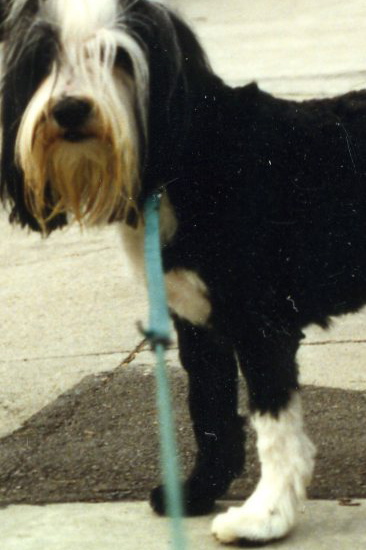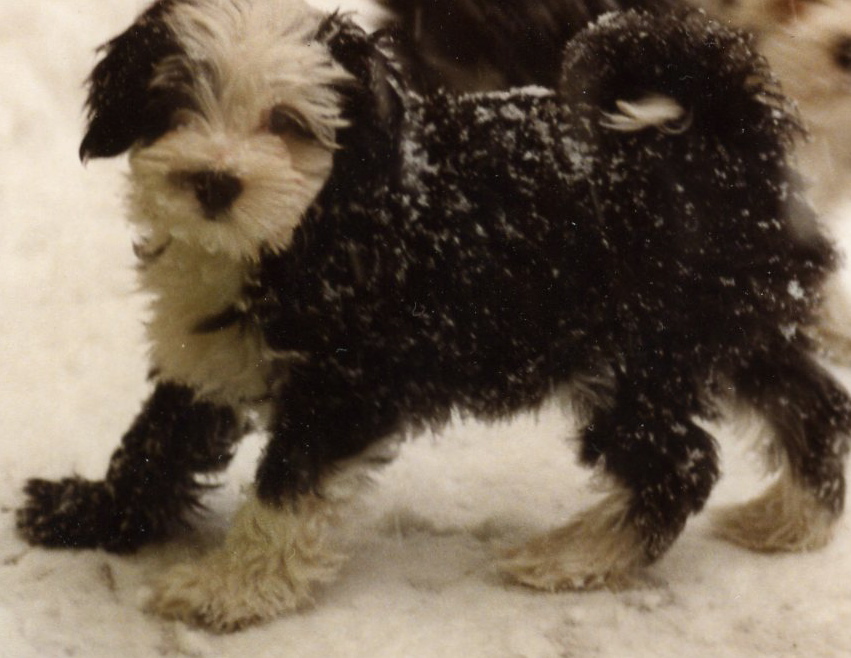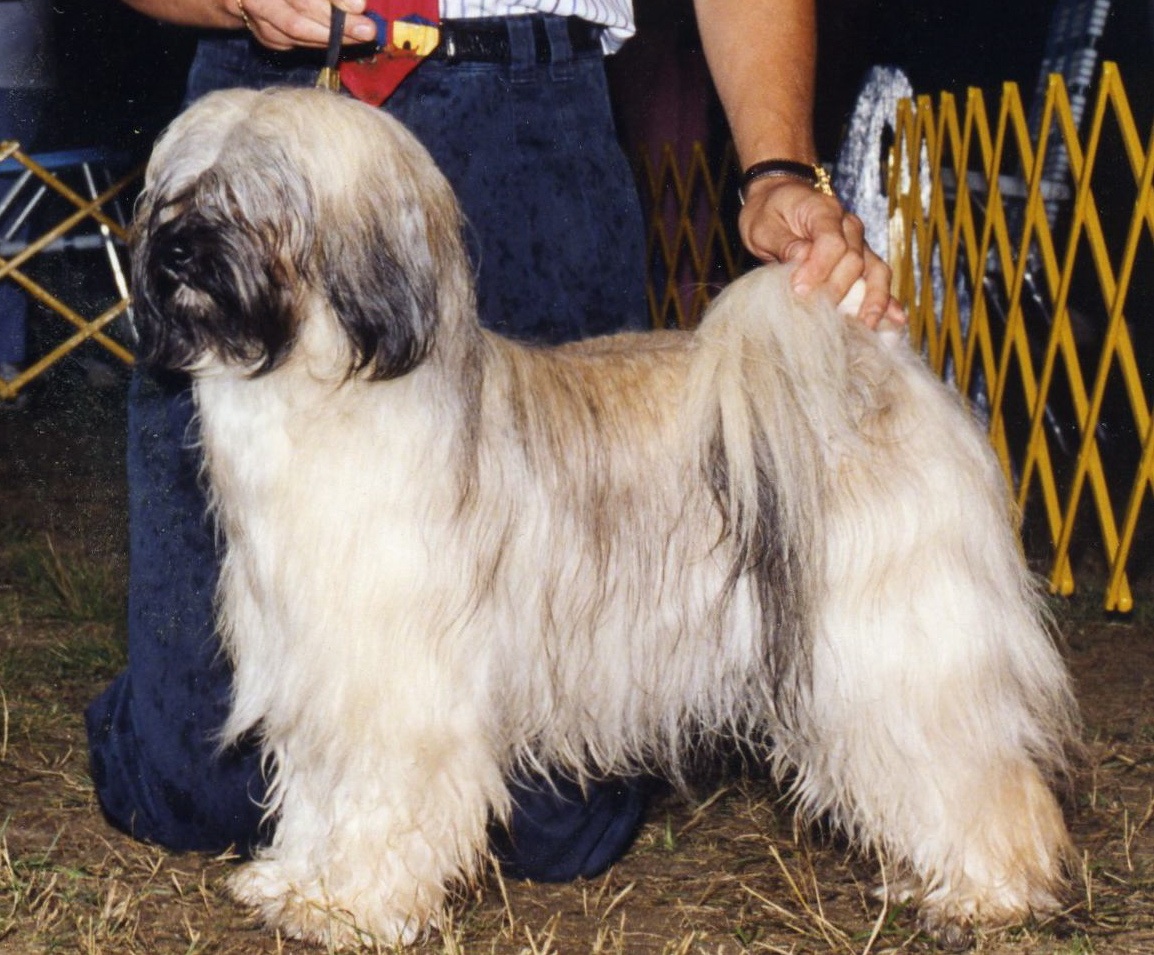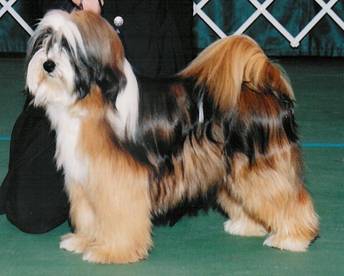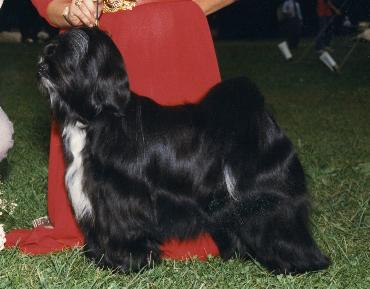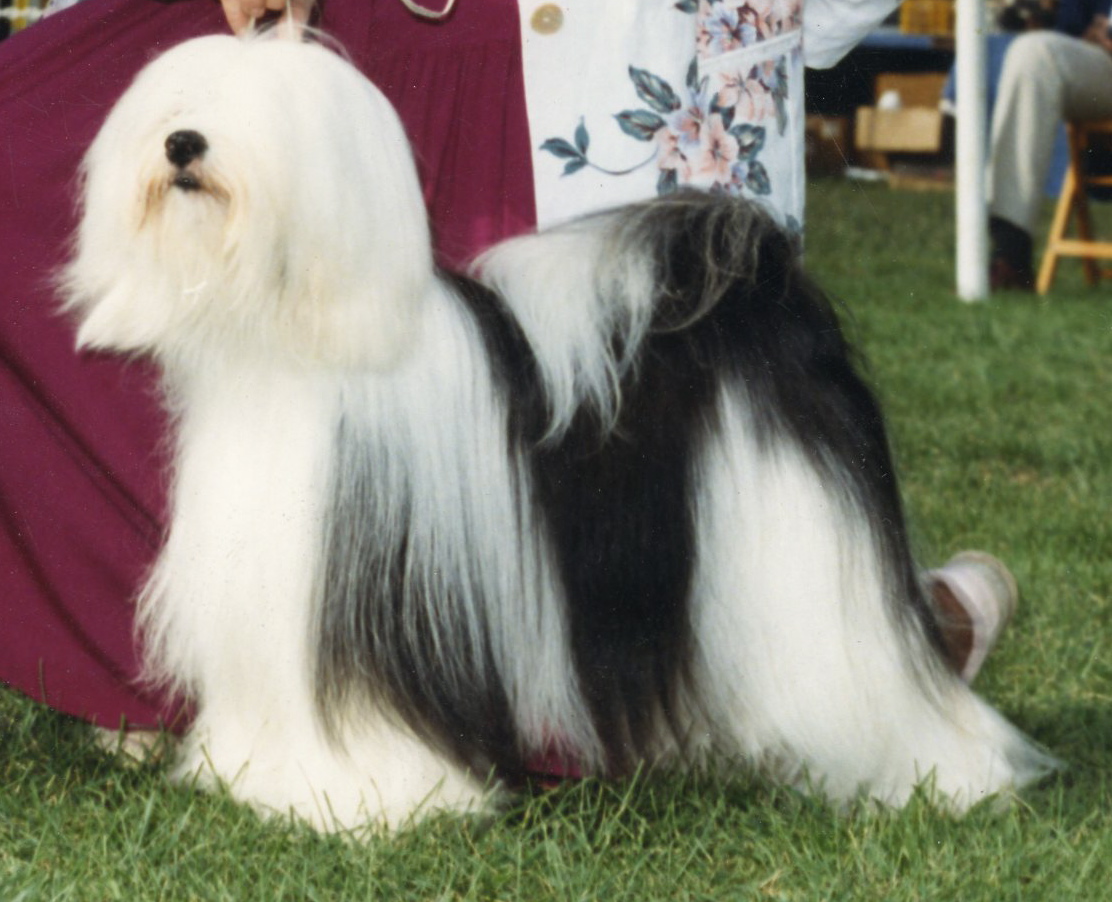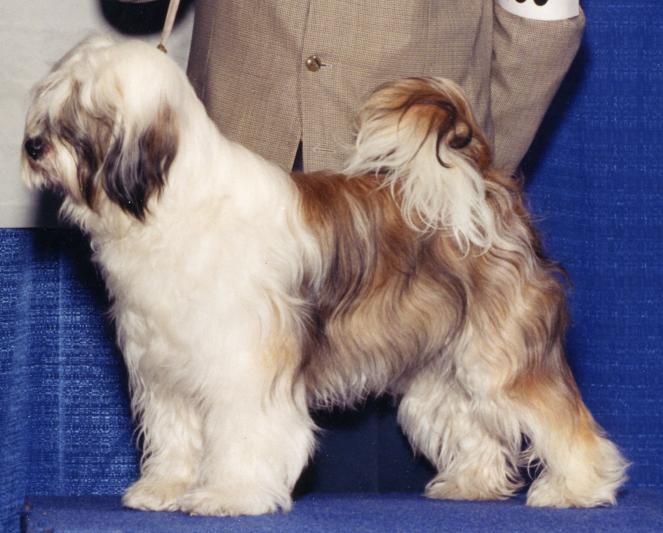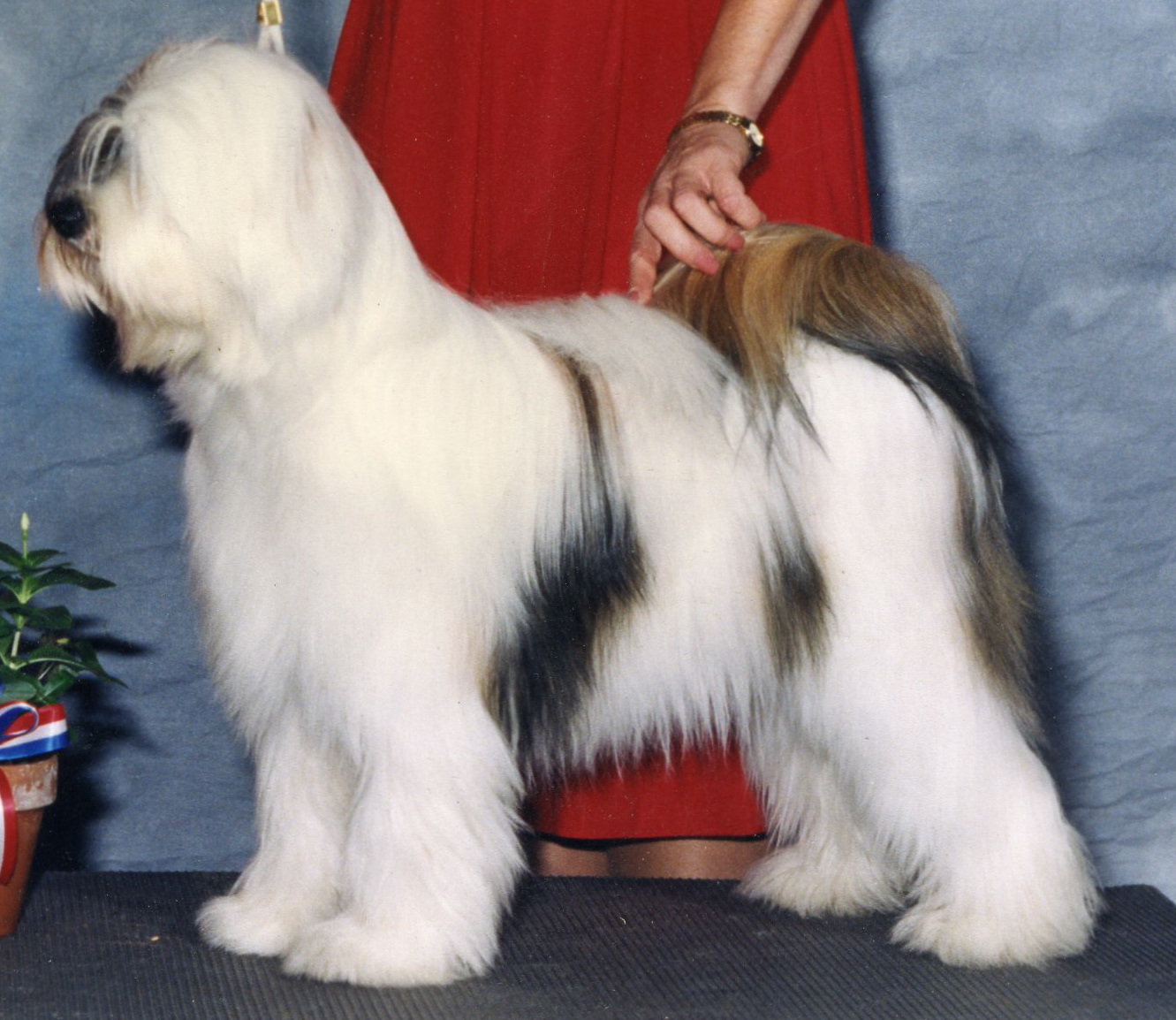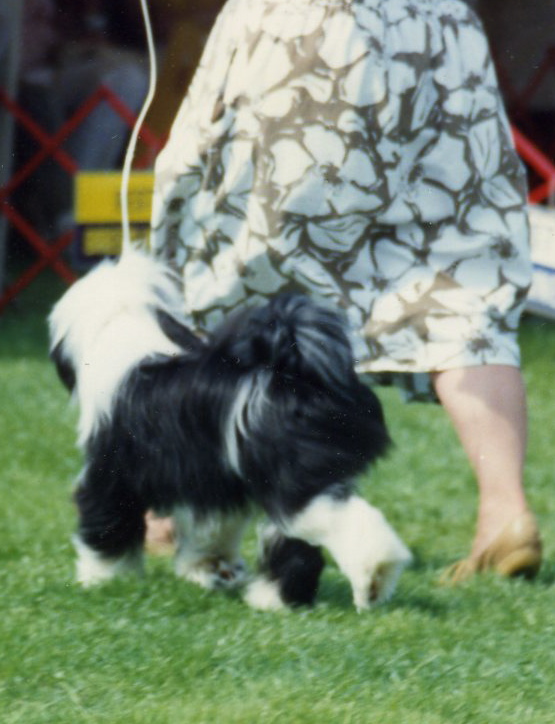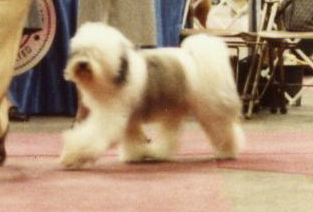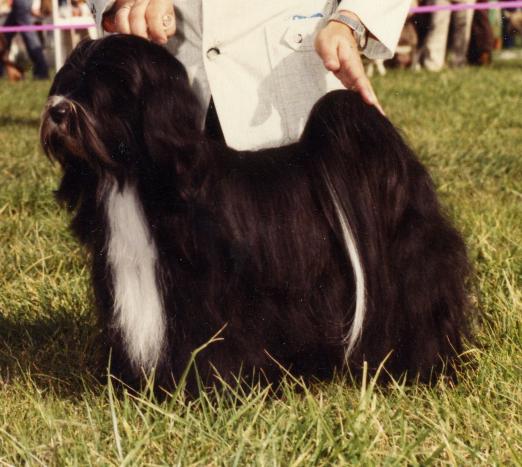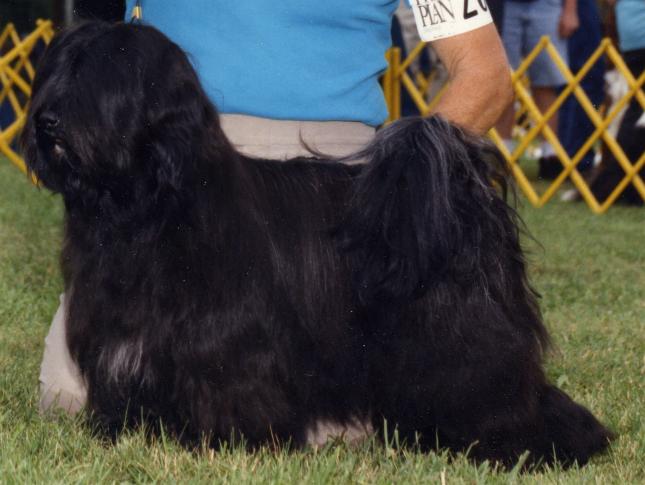Tibetan Terrier Breed Standard |
The Tibetan Terrier evolved over many centuries, surviving in Tibet's extreme climate and difficult terrain. The breed developed a protective double coat, compact size, unique foot construction, and great agility. The Tibetan Terrier served as a steadfast, devoted companion in all of his owner's endeavors. |
|
|
| The Tibetan Terrier is a medium-sized dog, profusely coated, of powerful build, and square in proportion. A fall of hair covers the eyes and foreface. The well-feathered tail curls up and falls forward over the back. The feet are large, flat, and round in shape producing a snowshoe effect that provides traction. The Tibetan Terrier is well balanced and capable of both strong and efficient movement. The Tibetan Terrier is shown as naturally as possible. |
|
|
|
| Skull--Medium length neither broad nor coarse. The length from the eye to the tip of the nose is equal to the length from eye to the occiput. The skull narrows slightly from ear to eye. It is not domed but not absolutely flat between the ears. The head is well furnished with long hair, falling forward over the eyes and foreface. The cheekbones are curved but not so overdeveloped as to bulge. |
|
Muzzle--The lower jaw has a small amount of beard.Stop--There is marked stop but not exaggerated. Nose--Black. |
|
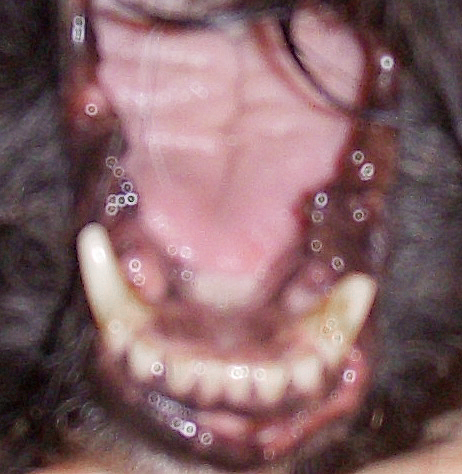 Teeth--White, strong and evenly placed. There is a distinct curve in the jaws between the canines. Teeth--White, strong and evenly placed. There is a distinct curve in the jaws between the canines.
|
|
|
|
|
A tight scissors bite, a tight reverse scissors bite or a level bite are equally acceptable. A slightly undershot bite is acceptable. |
|
|
|
|
|
|
scissors |
reverse |
level bite |
undershot |
|
|
| |
|
|
|
|
|
Eyes-- Large, set fairly wide apart, dark brown and may appear black in color, neither prominent nor sunken. Eye rims are dark in color. |
 |
Ears--Pendant, falling not too close to the head, heavily feathered with a "V" shaped leather proportionate to the head.
|
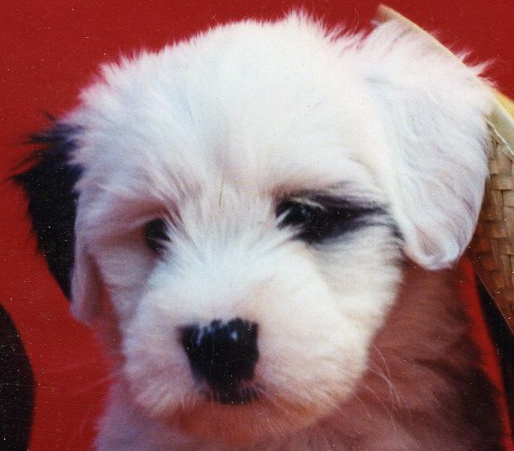 |
|
|
| |
|
Faults--Weak pointed muzzle. Any color other than a black nose. Overshot bite or a very undershot bite or a wry mouth. Long narrow head. Lack of fall over the eyes and foreface. |
|
|
|
| |
|
|
|
|
|
|
|
|
| Neck-- Length proportionate to the body and head. Body--Compact, square and strong, capable of both speed and endurance. |
| Topline--The back is level in motion. |
|
|
|
|
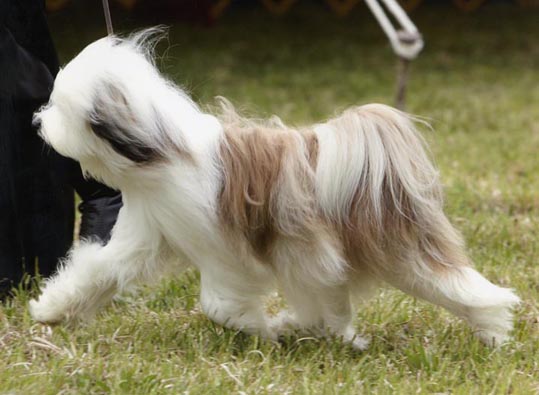 |
|
| |
|
|
Chest--Heavily furnished. The brisket extends downward to the top of the elbow in the mature Tibetan Terrier. Ribs--The body is well ribbed up and never cloddy or coarse. The rib cage is not too wide across the chest and narrows slightly to permit the forelegs to work free at the sides. |
Loin--Slightly arched. |
|
|
Tail--Medium length, heavily furnished, set on fairly high and falls forward over the back, may curl to either side. There may be a kink near the tip. |
|
|
|
Shoulders--Sloping, well muscled and well laid back. |
|
|
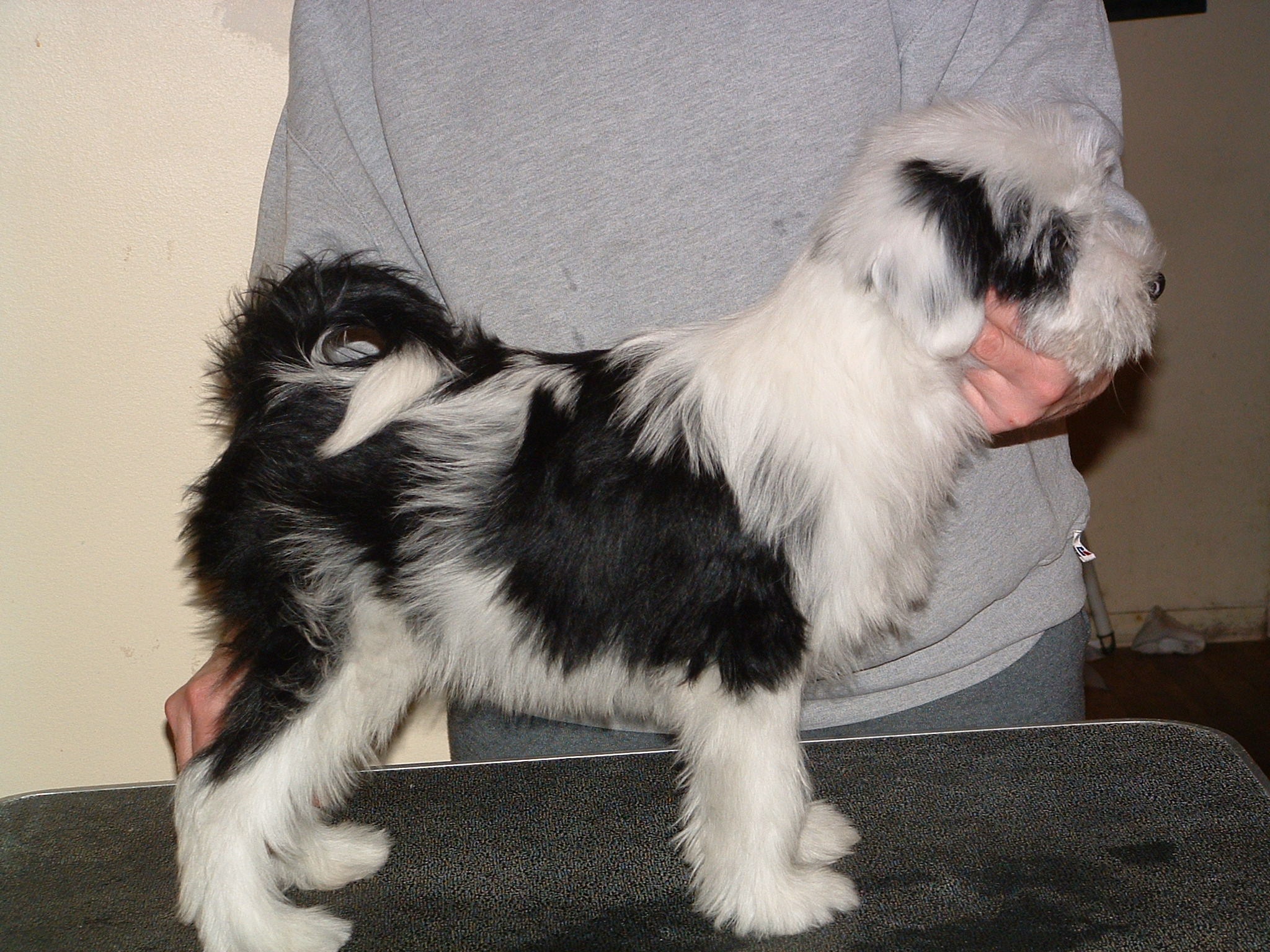 |
| Legs--Straight and strong when viewed from the front. Heavily furnished. The vertical distance from the withers to the elbow equals the distance from the elbows to the ground. |
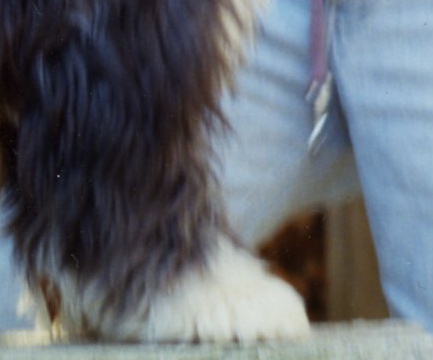 Feet--The feet of the Tibetan Terrier are unique in form among dogs. They are large, flat, and round in shape producing a snowshoe effect that provides traction. The pads are thick and strong. They are heavily furnished with hair between the toes and pads. Hair between the toes and pads may be trimmed level with the underside of the pads for health reasons. The dog should stand well down on its pads.Dewclaws--May be removed. Feet--The feet of the Tibetan Terrier are unique in form among dogs. They are large, flat, and round in shape producing a snowshoe effect that provides traction. The pads are thick and strong. They are heavily furnished with hair between the toes and pads. Hair between the toes and pads may be trimmed level with the underside of the pads for health reasons. The dog should stand well down on its pads.Dewclaws--May be removed. |
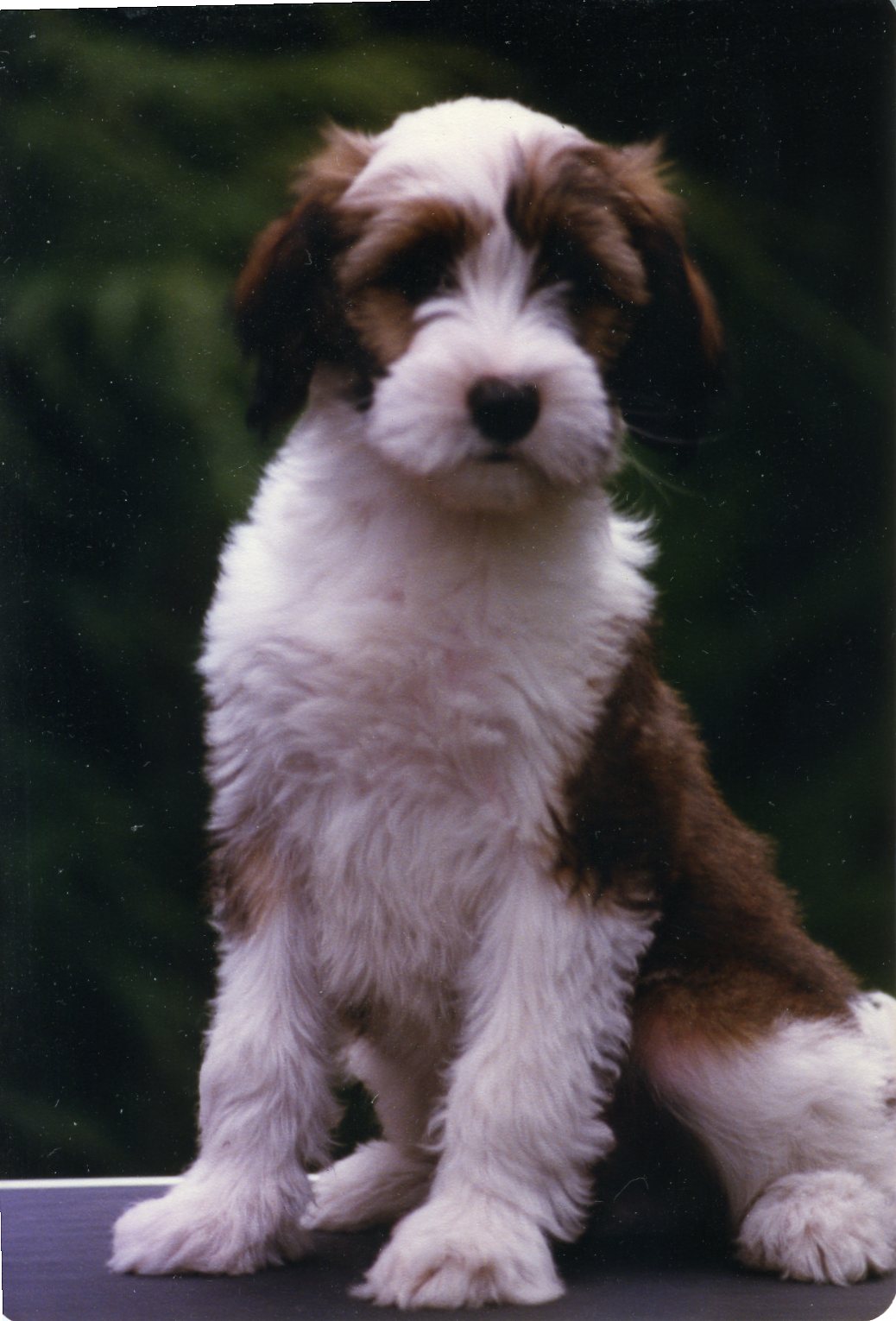 |
|
|
|
 |
Legs--Well furnished, with well bent stifles and the hind legs are slightly longer than the forelegs. Thighs--Relatively broad and well muscled. Hocks--Low set and turn neither in nor out. Feet--Same as forefeet. Dewclaws May be removed. |
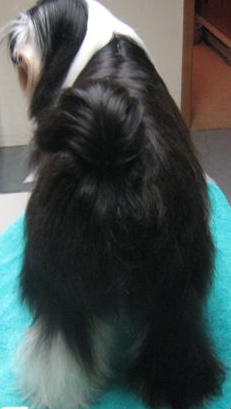 |
|
|
Double coat. Undercoat is soft and woolly. Outer coat is profuse and fine but never silky or woolly. May be wavy or straight. Coat is long but should not hang to the ground. When standing on a hard surface an area of light should be seen under the dog. The coat of puppies is shorter, single and often has a softer texture than that of adults. A natural part is often present over the neck and back. Fault--Lack of double coat in adults. Sculpturing, scissoring, stripping or shaving are totally contrary to breed type and are serious faults.
|
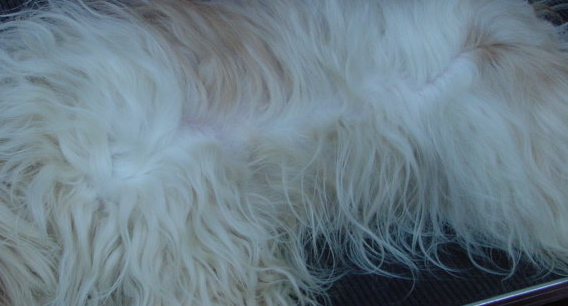 |
|
|
white |
gold |
golden brindle |
red brindle tricolor |
silver |
|
|
|
|
|
|
|
Any color or combination of colors including white are acceptable to the breed. There are no preferred colors or combinations of colors.
|
|
|
|
|
|
|
black |
black and white parti |
white and black |
brindle and white |
white and brindle |
|
|
|
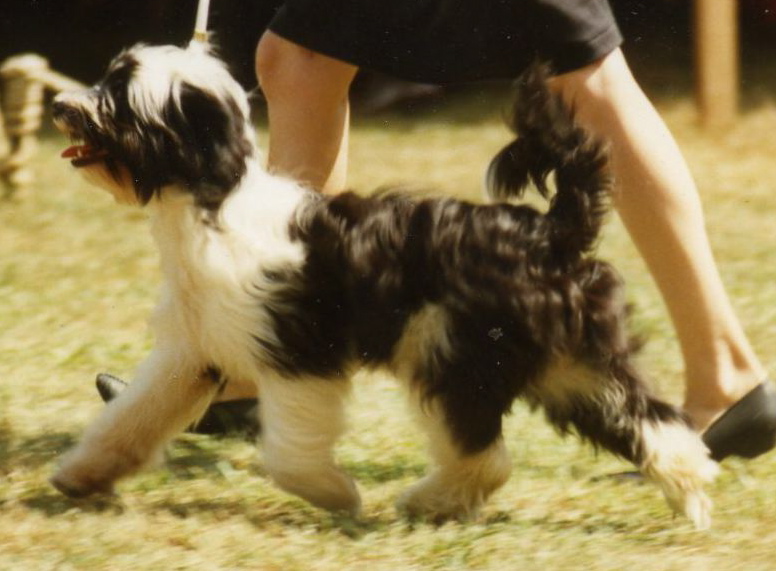
The Tibetan Terrier has a free, effortless stride with good reach in front and flexibility in the rear allowing full extension. When gaiting the hind legs should go neither inside nor outside the front legs but should move on the same track approaching single tracking when the dog is moved at a fast trot. The dog with the correct foot and leg construction moves with elasticity and drive indicating that the dog is capable of great agility as well as endurance.
|
|
|
|
|
Average weight is 20 to 24 pounds, but the weight range may be 18 to 30 pounds. Proportion of weight to height is far more important than specific weight and should reflect a well-balanced square dog. The average height in dogs is 15 to 16 inches, bitches slightly smaller. The length, measured from the point of shoulder to the root of tail, is equal to the height measured from the highest point of the withers to the ground. Faults--Any height above 17 inches or below 14 inches. |
|
male |
|
|
female |
|
| The Tibetan Terrier is highly intelligent, sensitive, loyal, devoted and affectionate. The breed may be cautious or reserved. Fault--Extreme shyness. |
| |
|
|
|
|
|
Tibetan Terrier Breed Standard
The Tibetan Terrier evolved over many centuries, surviving in Tibet's extreme climate and difficult terrain. The breed developed a protective double coat, compact size, unique foot construction, and great agility. The Tibetan Terrier served as a steadfast, devoted companion in all of his owner's endeavors.
General Appearance
The Tibetan Terrier is a medium-sized dog, profusely coated, of powerful build, and square in proportion. A fall of hair covers the eyes and foreface. The well-feathered tail curls up and falls forward over the back. The feet are large, flat, and round in shape producing a snowshoe effect that provides traction. The Tibetan Terrier is well balanced and capable of both strong and efficient movement. The Tibetan Terrier is shown as naturally as possible.
Head
Skull--Medium length neither broad nor coarse. The length from the eye to the tip of the nose is equal to the length from eye to the occiput. The skull narrows slightly from ear to eye. It is not domed but not absolutely flat between the ears. The head is well furnished with long hair, falling forward over the eyes and foreface. The cheekbones are curved but not so overdeveloped as to bulge. Muzzle--The lower jaw has a small amount of beard. Stop--There is marked stop but not exaggerated. Nose--Black. Teeth--White, strong and evenly placed. There is a distinct curve in the jaws between the canines. A tight scissors bite, a tight reverse scissors bite or a level bite are equally acceptable. A slightly undershot bite is acceptable.
Eyes-- Large, set fairly wide apart, dark brown and may appear black in color, neither prominent nor sunken. Eye rims are dark in color. Ears--Pendant, falling not too close to the head, heavily feathered with a "V" shaped leather proportionate to the head.
Faults--Weak pointed muzzle. Any color other than a black nose. Overshot bite or a very undershot bite or a wry mouth. Long narrow head. Lack of fall over the eyes and foreface.
Neck and Body
Neck-- Length proportionate to the body and head. Body--Compact, square and strong, capable of both speed and endurance. Topline--The back is level in motion. Chest--Heavily furnished. The brisket extends downward to the top of the elbow in the mature Tibetan Terrier. Ribs--The body is well ribbed up and never cloddy or coarse. The rib cage is not too wide across the chest and narrows slightly to permit the forelegs to work free at the sides. Loin--Slightly arched. Tail--Medium length, heavily furnished, set on fairly high and falls forward over the back, may curl to either side. There may be a kink near the tip.
Forequarters
Shoulders--Sloping, well muscled and well laid back. Legs--Straight and strong when viewed from the front. Heavily furnished. The vertical distance from the withers to the elbow equals the distance from the elbows to the ground. Feet--The feet of the Tibetan Terrier are unique in form among dogs. They are large, flat, and round in shape producing a snowshoe effect that provides traction. The pads are thick and strong. They are heavily furnished with hair between the toes and pads. Hair between the toes and pads may be trimmed level with the underside of the pads for health reasons. The dog should stand well down on its pads. Dewclaws--May be removed.
Hindquarters
Legs--Well furnished, with well bent stifles and the hind legs are slightly longer than the forelegs. Thighs--Relatively broad and well muscled. Hocks--Low set and turn neither in nor out. Feet--Same as forefeet. Dewclaws May be removed.
Coat
Double coat. Undercoat is soft and woolly. Outer coat is profuse and fine but never silky or woolly. May be wavy or straight. Coat is long but should not hang to the ground. When standing on a hard surface an area of light should be seen under the dog. The coat of puppies is shorter, single and often has a softer texture than that of adults. A natural part is often present over the neck and back. Fault--Lack of double coat in adults. Sculpturing, scissoring, stripping or shaving are totally contrary to breed type and are serious faults.
Color
Any color or combination of colors including white are acceptable to the breed. There are no preferred colors or combinations of colors.
Gait
The Tibetan Terrier has a free, effortless stride with good reach in front and flexibility in the rear allowing full extension. When gaiting the hind legs should go neither inside nor outside the front legs but should move on the same track approaching single tracking when the dog is moved at a fast trot. The dog with the correct foot and leg construction moves with elasticity and drive indicating that the dog is capable of great agility as well as endurance.
Size
Average weight is 20 to 24 pounds, but the weight range may be 18 to 30 pounds. Proportion of weight to height is far more important than specific weight and should reflect a well-balanced square dog. The average height in dogs is 15 to 16 inches, bitches slightly smaller. The length, measured from the point of shoulder to the root of tail, is equal to the height measured from the highest point of the withers to the ground. Faults--Any height above 17 inches or below 14 inches.
Temperament
The Tibetan Terrier is highly intelligent, sensitive, loyal, devoted and affectionate. The breed may be cautious or reserved. Fault--Extreme shyness.
STOP IT, STOP IT, STOP IT
The Tibetan Terrier breed standard uses some unusual language for describing a correct Tibetan. For example, the breed is described as square, but it is a square only in the skeletal sense of what you feel with your hands from point of shoulder to root of tail being equal to the height measured from the highest point of withers to the ground. Due to the forechest, buttocks, and coat, the correct mature Tibetan Terrier looks rectangular, not square, when viewed from the side. Think more yak, less SpongeBob.
A second confusing description is the 50:50 head. To understand what is really wanted, it is necessary to know the correct starting point for the center of balance. Look down from the head from above: Does it look like a chrysanthemum, one of the original names for the breed?
According to Hutchinson’s Dog Encyclopedia, the original Indian standard for the Tibetan Terrier called for a marked stop in front of the eyes, not to be exaggerated or dishy. Thus it is clear that the eyes are behind the stop. Then: “The length from eye to tip of nose is about one-fifth or one-quarter less that that from eye to back of skull.” But our current (1987) standard calls for this measurement to be of equal length. So how do we correctly evaluate this part of the head? Excessive length of muzzle, especially without adequate stop, is a common fault found in today’s TTs.
For many years, I have observed judges evaluate TT heads by measuring from the stop. This yields a completely incorrect Tibetan Terrier head. The stop is 3/4 inch to 1 1/4 inch in front of the eye on the correct TT head. The muzzle (nose tip to stop) should be considerably shorter than the skull (stop to occiput). If the correct head is 50:50 from eye to tip of nose, and the eye is one inch behind the stop, then the muzzle should be about 2 1/4 – 2 1/2 inches and the skull 4 1/2 – 5 inches, or about 1:2 ratio of the muzzle:skull on the average 15 1/2-inch, 26-pound dog. The center point of the head is not the stop, but the eye. The eye is behind the stop, father away from the nose. The standard describes a head with a muzzle that is approximately one-third of the total skull length, or a 1:2 muzzle:skull ratio.
The greatest width of the skull is found between the eye and the ear. When you place your fingers on the widest part, the zygomatic arch, over the top of the skull, the roundness of the top of the skull will fill the arch created between your thumb and forefinger. The top of the skull is neither domed like an English Toy Spaniel nor flat like a Collie, but should be well-rounded, which, in conjunction with the marked stop, prevents the Tibetan Terrier head from being down-faced.
While the breed standard may be somewhat unusual in its points of reference, that seems only right for this unusual breed. Dr. Greig did know her anatomy, and her description of the head means exactly what she says. To be fair and balanced, please stop stopping it; the eyes have it. –Toodie Connor, DVM
EVALUATING THE BITE
The Tibetan Terrier breed standard is written in anatomical order. Since there is only one serious fault, we know it is important. So how do we learn to evaluate the other points addressed in the standard in order of importance? Where does bite fit?
To understand the standard first picture the dog in Tibet. Despite the terrier name given to the breed in the West, these dogs were not bred to be vermin catchers. They lived with the nomads and their flock – not as guard dogs or herders, but as tent-mates and sentinels.
The original imports from Tibet had a wide variety of bites and many fewer teeth than the expected full Western dentition of 42 teeth. Since then, breeders have strongly selected for full dentition. As a veterinarian, I fully support this direction because, regardless of the breed, we must select for functional mouths. A fault like a wry bite causes a physical problem for the dog and should be penalized. The exact number of incisors and how they meet is not a matter of great importance in Tibetans. Jaw shape. Substance, color, and look are more important.
The TT standard allows as equal bites that are slightly undershot, level, reverse scissors, and scissors. No one bite in inherently better than the others. Period. Even undershot bites are only slightly penalized.
So what is important about evaluating the bite? First, the shape of the muzzle affects the look of the face. Snippiness is a fault because the lack of substance at the end of the nose, combined with a narrow lower jaw, is inherently more fragile and subject to injury. When viewed head on, the foreface should be square to round – neither pointy, nor too long, nor too short. The nose needs to be large enough to allow an adequate air stream to flow to the lungs, but not so large or coarse as to allow chilled air to reach the lungs.
Substance is more easily maintained in the lower jaw with a reverse scissors bite. This is important to maintaining the correct look of the breed – a slightly pouty, slightly reversed “look of eagles.” When a Tibetan is moving toward you, he should smile at you. For that look, the lower jaw needs to be U-shaped not V-shaped. This is much more important than the placement of the incisors. Early reports of the breed also mentioned that the upper corner incisors were larger than the central incisors and were shaped like a smaller version of the adjacent canine tooth.
So why are all four bites considered equal? Reverse scissors and slightly undershot are preferred because they most strongly contribute to correct type – good substance and strong Oriental look. Although a level bite is somewhat les functional due to increased tooth wear, it maintains the substance and look of the underjaw. Scissors has been added to the standard as correct because it is the most stable to breed for, and as long as snippiness remains a fault, it hopefully will not lead to a lack of substance.
Bottom line: Equal is equal. Four good strong incisors are better than six weak ones. A strong jaw is better than a weak one. Focus on the important things like muscle, balance, and condition. Reverse scissors, slightly undershot, level, or scissors – it just isn’t that important. --Toodie Connor, DVM
CAUGHT FLAT-FOOTED
The current Tibetan Terrier standard says the breed has unique foot construction. It adds, The feet of the Tibetan Terrier are unique in form among dogs. These are strong statements indeed. The original TT standard as quoted in Hutchinson describes the unique flat foot of the TT as “ . . . large and round. Well-furnished with hair between the toes. The dog stands well down on its pads, not up on its toes.”
But what exactly makes the Tibetan foot so unique? To answer this question, we need look at their land of origin. Picture the rocky, dry terrain. See the dogs following their nomadic family over narrow mountain trails; traversing high passes; and following the yaks, sheep, and ponies. Visualize deep snow in the winter and deep mud in the spring. Like many breeds that lived with nomadic people, they had to be tough enough to travel with the group. Good feet are critical to survival in challenging climates. The TT foot had to be tough to travel long distances, but also flexible enough to grip and hold. Anyone who has ever tried to extract a TT from a crate when it is resisting has experienced the ability of Tibetan toes to grab and hang on! Part of this flexibility comes from the lack of arch in the TT foot. Think of the difference between the gripping ability of a child with normal straight fingers and that of an old person whose fingers are bent from arthritis.
What does round mean? Round refers to the anterior-to-posterior and medial-to-lateral diameter across the bottom of the foot as being approximately equal, and thus distributing the dog’s weight across the entire foot, providing for greater traction. The hair that grows between the pads helps protect the bottom of the pads and also provides insulation from the frozen snow and ice in the winter. This hair needs to be trimmed occasionally in dogs that live on softer ground as most of our pets do and is allowed by our standard.
To protect the joints, the pads also need to be thick and strong. This thickness extends to both the skin on the bottom of the pad and the underlying tissues. The ideal foot has a thick, fleshy area around the center of the pads.
Pick up the foot with the thumb tip just in front of the center pad and your first three fingers on top of the foot. There should be a feeling of resilience, of slight resistance. In other words, a well-padded foot.
When the dog is standing and you run your hand down the leg, there is a smooth transition from the leg to the ankle to the toes. No arch is present over the toes. The feel is like the transition on your own arm and hand. This is one of the primary ways Tibetan Terriers differ from their cousins, the Tibetan Spaniels and Lhasa Apsos.
The standard does not mean that the foot should be trimmed to look round. That would, of course, be committing the only “serious fault” (scissoring, sculpturing, stripping, or shaving) in our standard since disqualifications were eliminated.
I’m looking forward to the spring rains and the return of those unique, wet, muddy, and round footprints all over the house! --Toodie Connor, DVM
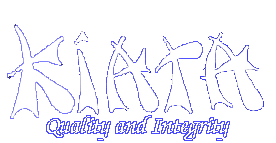

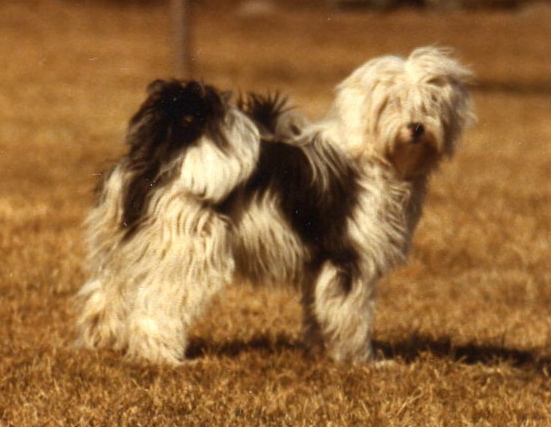
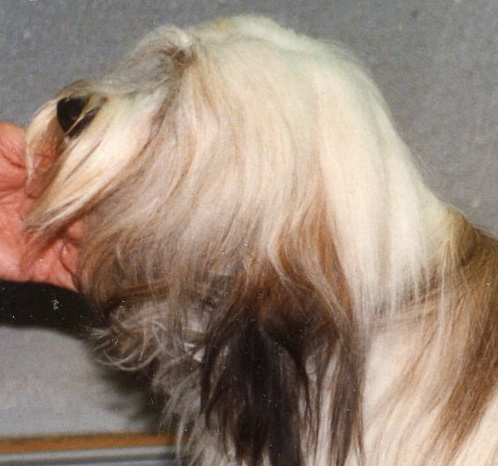
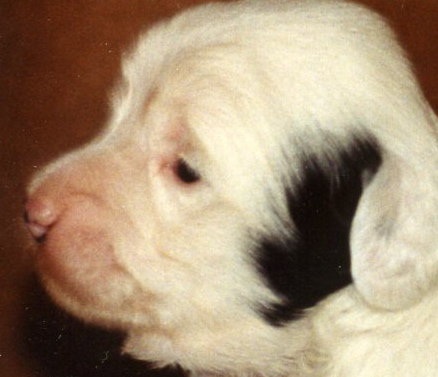
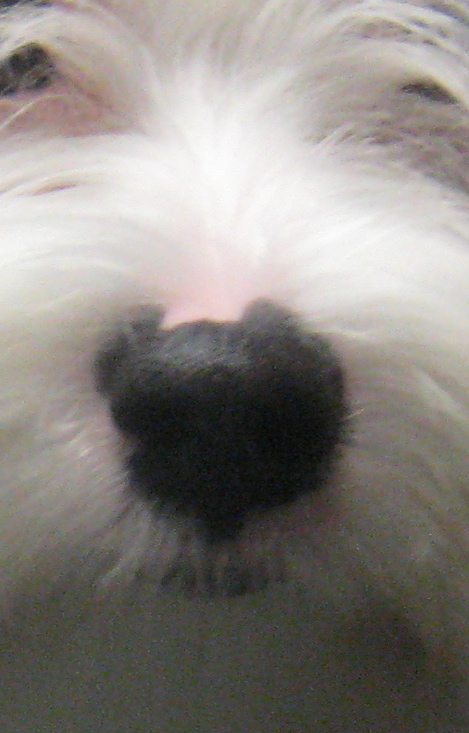
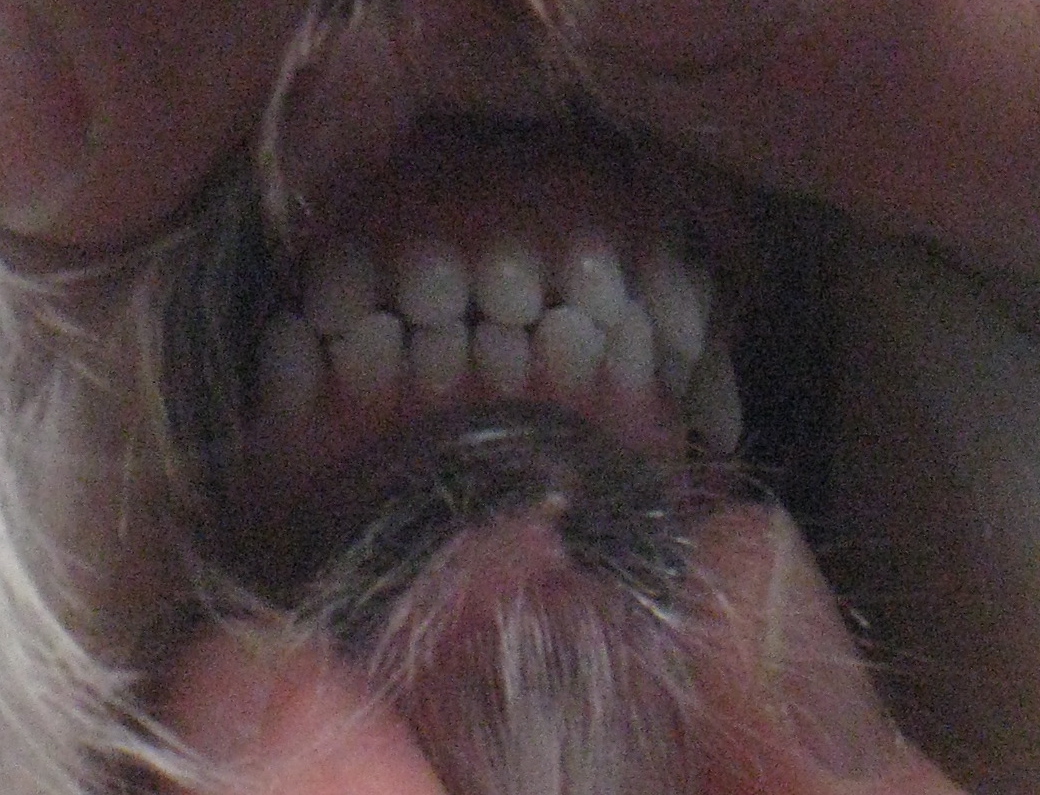


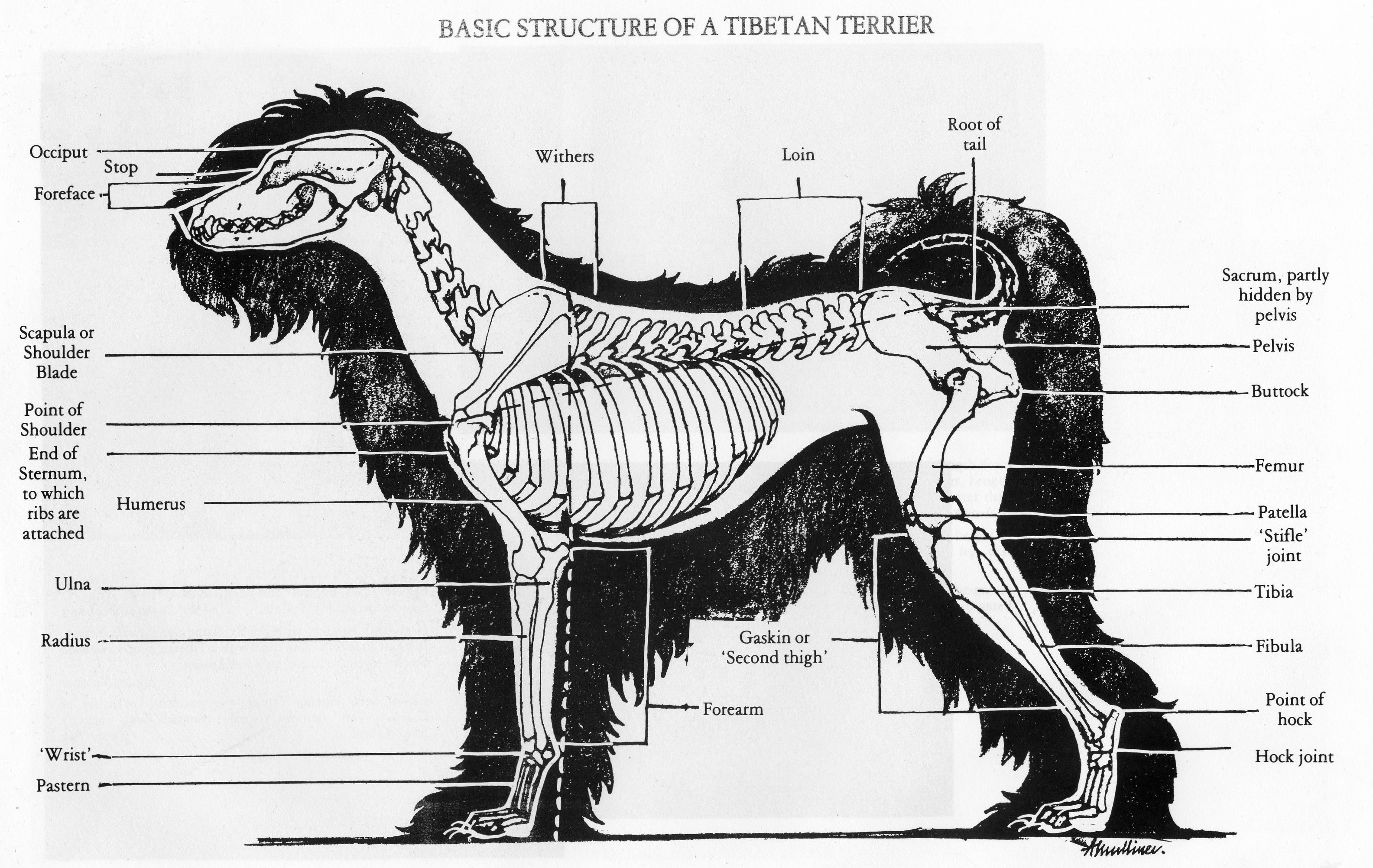
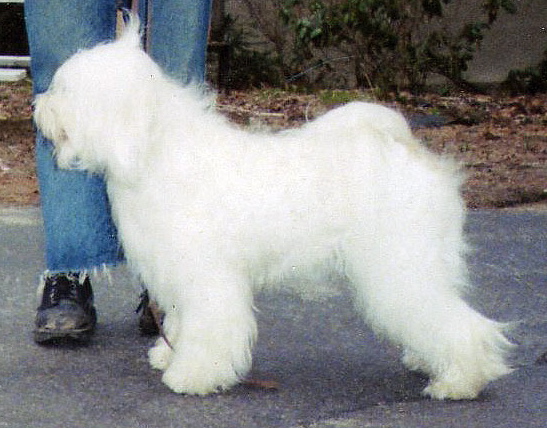

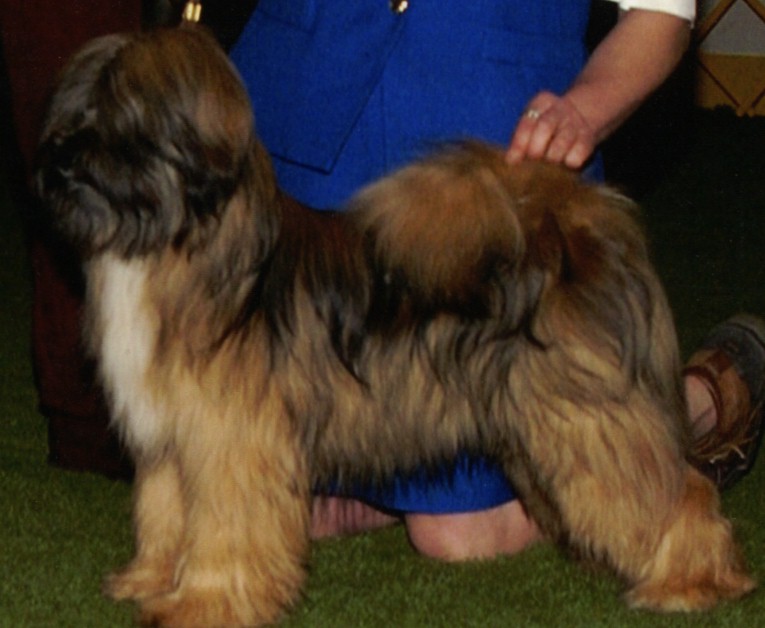
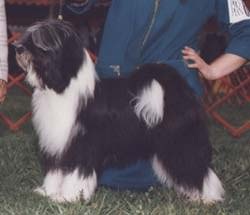
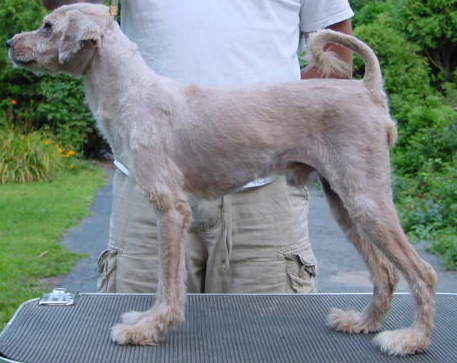
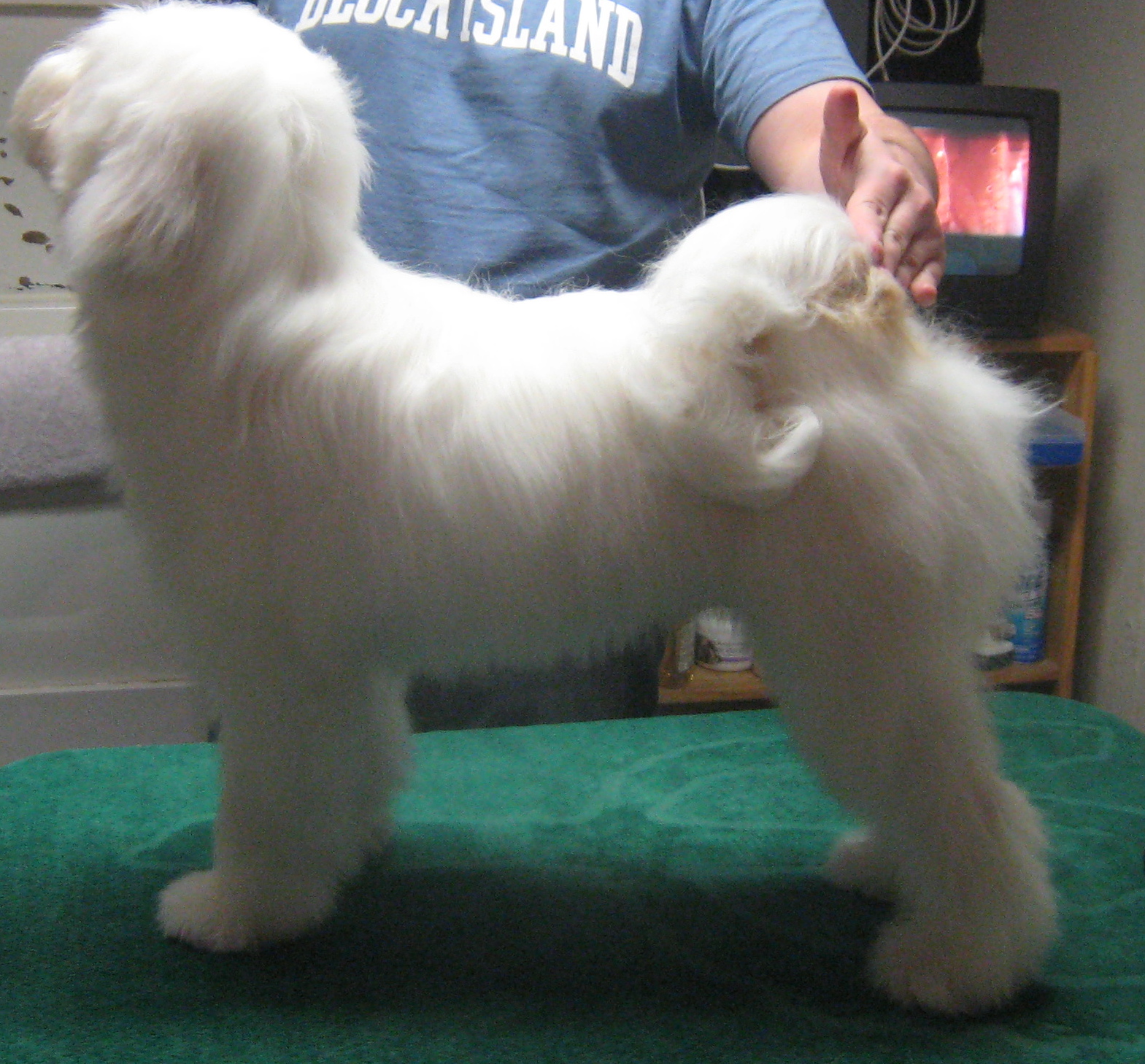
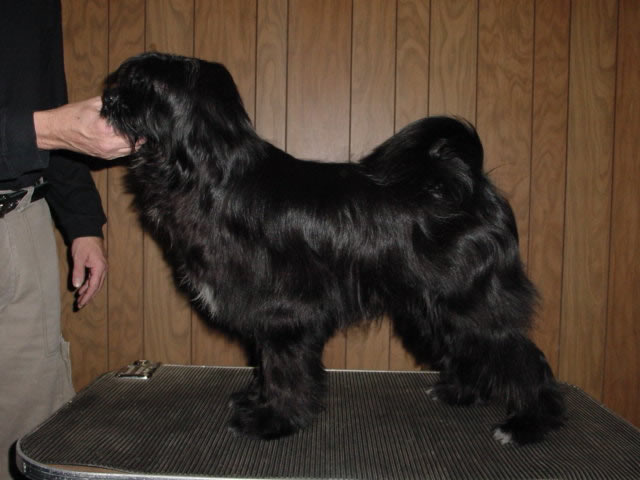
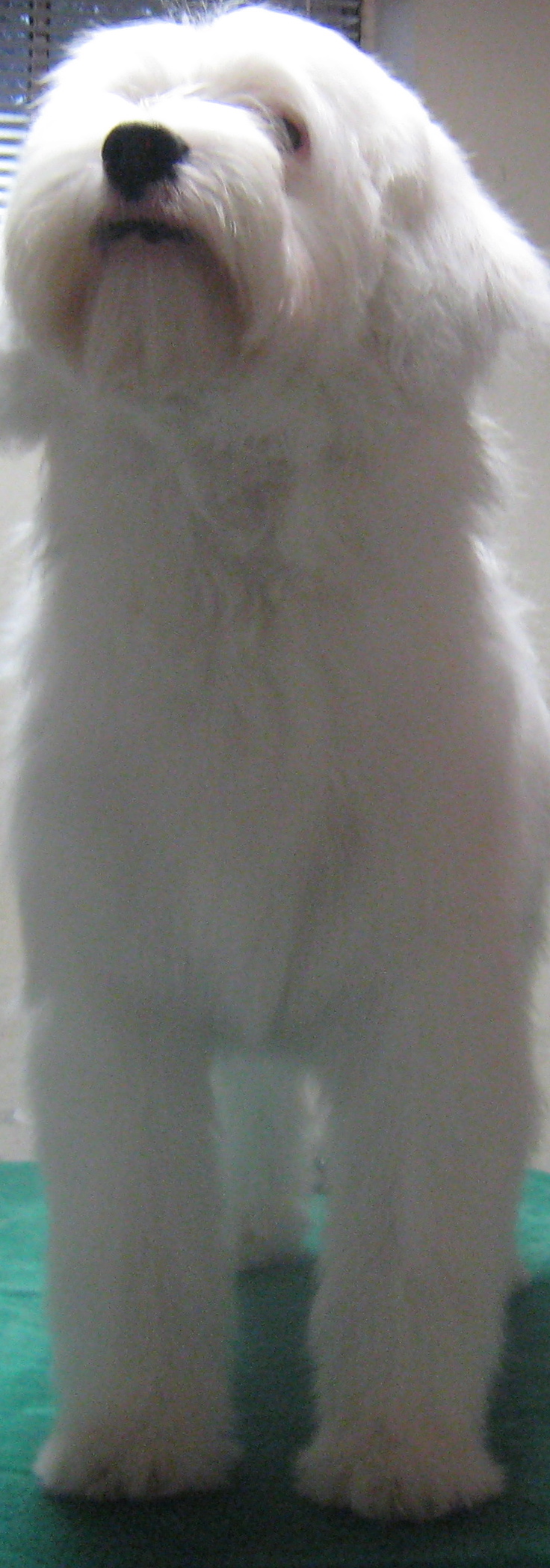

 Feet--The feet of the Tibetan Terrier are unique in form among dogs. They are large, flat, and round in shape producing a snowshoe effect that provides traction. The pads are thick and strong. They are heavily furnished with hair between the toes and pads. Hair between the toes and pads may be trimmed level with the underside of the pads for health reasons. The dog should stand well down on its pads.Dewclaws--May be removed.
Feet--The feet of the Tibetan Terrier are unique in form among dogs. They are large, flat, and round in shape producing a snowshoe effect that provides traction. The pads are thick and strong. They are heavily furnished with hair between the toes and pads. Hair between the toes and pads may be trimmed level with the underside of the pads for health reasons. The dog should stand well down on its pads.Dewclaws--May be removed.
